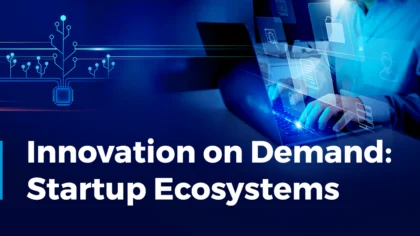Accelerate Productivity in 2025
Reignite Growth Despite the Global Slowdown
Innovation is now essential to the survival of businesses, and startups and scaleups are key players in this effort. This also means emerging companies that are developing disruptive technology and agile business models are posing an unprecedented threat to established companies. To thrive in this new environment, companies can use global startup ecosystems to support innovation, quickly adjust to shifting market conditions, and maintain competitive advantages.
Executive Summary:
Businesses need innovation to survive. Established companies face threats from emerging startups. Startup ecosystems offer a network of resources and partners to accelerate innovation.
How to leverage startup ecosystems:
- Startup Scouting: Find promising startups with complementary solutions, tech, or market reach.
- Open Innovation Programs: Collaborate with startups through programs for pilot projects or joint product development.
Success factors include:
- Matching Startups: Evaluate fit based on experience, technology strength, and market alignment (target market, customer validation, etc.).
- Strategic Partnerships: Clear goals, open communication, and commitment from both sides are crucial.
The takeaway: Engage with startup ecosystems to find innovative solutions, accelerate growth, and stay competitive.
Startup Ecosystems: A Breeding Ground for Innovation
A startup ecosystem is a dynamic network of interconnected organizations, including investors, universities, research institutes, accelerators, incubators, and companies, who collaborate to promote innovation and entrepreneurship. These ecosystems provide an abundance of talent, resources, and creative solutions that have the potential to drive growth. By interacting with these ecosystems, businesses can quickly accelerate their innovation processes and product development cycles by gaining access to new technology and business models.
How to Leverage Startup Ecosystems for Growth
Startup Scouting: Unveiling the Hidden Gems
Scouting startups involves proactively looking for them within the innovation ecosystem. Businesses can unlock new growth opportunities by identifying which cutting-edge technologies and business models align with their corporate goals. Think of a healthcare company searching for startups offering AI-powered diagnostics. This collaboration may result in the creation of new approaches that enhance patient outcomes.
Startup discovery can provide a number of strategic advantages in addition to simply locating possible partners:
- Collaborations: Finding companies that offer complimentary products, which could result in prospects for pilot projects or coordinated marketing strategies.
- Tech Landscaping and Innovation Landscaping: Understanding the new technologies that are pertinent to certain businesses and the larger innovation environment.
- Industry Analysis & Trend/Tech Identification: By examining the startup scene, companies can gain important insights into emerging technologies and industry trends.
- Competitive analysis: Finding businesses with similar markets or client groups uncovers the competitive landscape.
- Enhance/Substitute Internal Work: To maximize efficiency and innovation velocity, businesses can use startup skills to enhance or replace internal work in some areas.
- Investment Opportunities: Locating potential opportunities for mergers and acquisitions (M&As), speeding up entry into untapped sectors or technologies.

Open Innovation and Startup Initiatives: Teamwork Is Essential
Companies that use open innovation as a strategic approach can complement their internal R&D efforts by utilizing external resources. Startup programs — also known as startup calls or open innovation challenges — provide an organized framework for businesses to work with startups. Through the combination of established B2B companies’ resources and market reach with the agility and innovative capabilities of startups, these programs enable the co-development of new solutions. Engaging in these programs requires a strategic approach, focusing on mutual benefits and aligned goals.
There are several use cases for businesses to work with startups in this model:
- Proof of Concept (PoC)/Pilot Programs: Using pilot projects with potential startups, test and validate the viability of a new technology or business model.
- Licensing: Acquiring the rights to utilize a startup’s technology or intellectual property, accelerating product development or expanding capabilities.
- Soft Landing Programs: These programs help promising startups grow into new markets or relocate their operations, forming profitable alliances in the process.
- Investing: Putting money up front and supporting innovation at the same time by funding promising startups directly or through accelerators, corporate VC arms, or other means.
Identifying the Proper Fit for Strategic Partnerships
Finding the best startups and tech companies requires comparing certain criteria to prospective partners’ technologies and solutions. Important factors include the team’s experience, the solution’s market fit, and the strength of the startup’s technology.
Readiness for Technology
- Technical Feasibility: Evaluate the fundamental technology and its guiding principles’ technical soundness. Think about things like:
- Novelty: Does the technology provide a fresh approach or a notable advancement over already-existing approaches?
- Scalability: Is the technology able to grow and change to meet new requirements?
- Security: Does the technology safeguard sensitive data with strong security measures?
- Integration Complexity: What is the ease of integration between the technology and your current systems and infrastructure?
- Development Stage: Take technological maturity into account. Is it an established solution, or is it just getting started? Your desired implementation timeline and level of risk tolerance will determine which stage is right for you.
- Intellectual Property (IP): Assess the quality of the startup’s portfolio of intellectual property, which includes trademarks, copyrights, and patents. This guarantees them a competitive edge that can be defended.
Experience
- Domain Expertise: Does the team have a thorough understanding of the problem they are trying to solve and in-depth knowledge of the industry?
- Technical Proficiency: Does the founder/team possess the technical expertise required to create and manage the technology efficiently?
- Track Record: Consider the group’s prior accomplishments and shortcomings. Have they previously created profitable goods or businesses?
- Leadership: Evaluate the founding team’s leadership capabilities. Are they tenacious, imaginative, and able to overcome obstacles?
- Team Culture: Assess the culture of the startup’s team. Is it flexible, inventive, and cooperative? Long-term success depends on having a strong team culture.
- Adaptability: To what extent can the team change course and modify its plans in response to feedback from the market or new obstacles?
Market Alignment
- Target Market: Clearly identify the market that the startup’s solution is aimed at, and make sure that it coincides with your own clientele or planned growth regions.
- Market Size and Growth Potential: Assess the target market’s size and room for expansion. Is the market big enough to sustain a successful collaboration?
- Customer Validation: Evaluate the startup’s degree of customer validation. Are their current clients paying for and using their solution?
- Competitive Advantage: Does the solution offer clear benefits over products on the market now, whether it be in terms of price, effectiveness, or innovation?
- Competitive Landscape: Are there established players in the market, and how does the startup’s solution differentiate itself?
- Go-to-Market Strategy: Assess the startup’s approach to the market and its capacity to successfully connect with its intended audience.
Value is created for both parties when established companies and startups form strategic partnerships. B2B organizations profit from enhanced innovation velocity and access to new technologies, while startups benefit from established market channels, resources, and expertise. These partnerships lead to significant innovations, driving growth and market success for both parties.
The Sustainable Agri-Livestock Innovation Challenge at Iberdrola: An Open Innovation Case Study
A number of well-established businesses are already effectively utilizing startup ecosystems, leading to revolutionary breakthroughs and expansion.
For instance, the multinational energy corporation Iberdrola uses a cooperative strategy for open innovation. To electrify and decarbonize the agriculture and livestock sectors, Iberdrola partnered with StartUs Insights to launch a targeted open innovation challenge.
This is how the partnership made success possible:
- Focused Outreach: Through the use of StartUs Insights’ expert team and the AI-powered Discovery Platform, the program found and contacted 2000 relevant startups worldwide. This guaranteed a large number of eligible candidates.
- Targeted Advertising: The challenge received more traction thanks to a well-designed, conversion-optimized promotional campaign that attracted applications from 30 different countries.
- Quality Applications: As a result of these initiatives, Iberdrola obtained nearly one hundred applications, showcasing the effectiveness of the open innovation approach.
The partnership between Iberdrola and StartUs Insights showcases the importance of approaching open innovation with purpose and strategy. Employing technology and outside knowledge thus allows businesses to reach a larger audience and draw in more creative solutions.
It’s Time to Take Action
The competitive landscape in business now favors adaptability over speed. Businesses that don’t adopt innovation run the risk of falling behind.
Startup ecosystems provide a strong foundation for growth and innovation acceleration. Business leaders who tap into these opportunities gain a competitive advantage and guarantee their long-term success by actively participating in these ecosystems.


![Business Resilience Planning: 10 Strategies & Technologies to Tackle the Current Market [2025-2026]](https://www.startus-insights.com/wp-content/uploads/2025/06/Business-Resilience-Planning-SharedImg-StartUs-Insights-noresize-420x236.webp)
![10 Biggest Business Trends: What to Invest in, Build, and Watch Closely [2025-2030]](https://www.startus-insights.com/wp-content/uploads/2025/06/Business-Trends-SharedImg-StartUs-Insights-noresize-420x236.webp)




